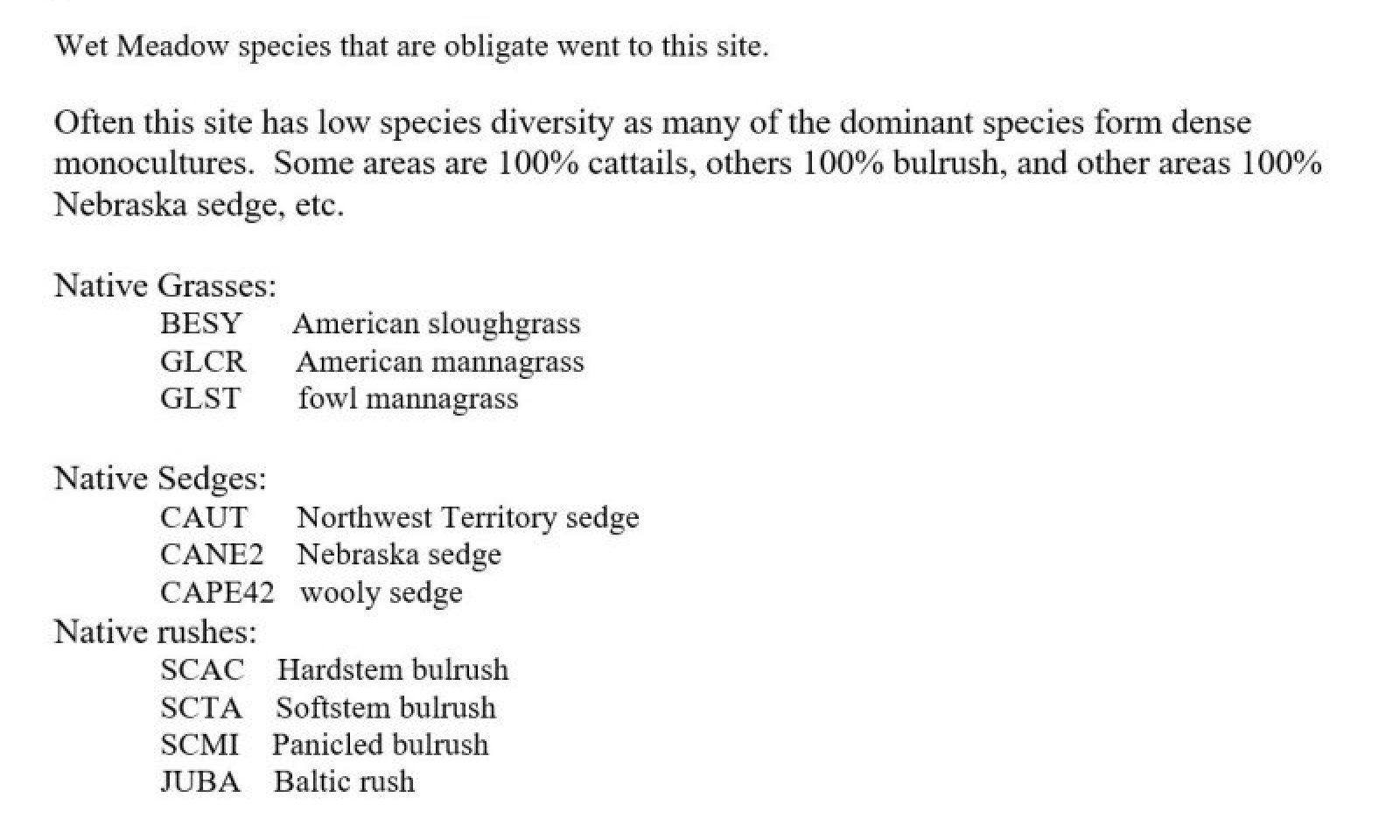
Wetland Complex
Scenario model
Current ecosystem state
Select a state
Management practices/drivers
Select a transition or restoration pathway
-
Transition T1
Intensive disturbance to hydrology, soils, or vegetative cover.
More details -
Restoration pathway R2
Repair of hydrologic processes, dredging, planting and weed control
More details -
Transition T3
lack of management, disturbance
More details -
No transition or restoration pathway between the selected states has been described
Target ecosystem state
Select a state
Description
State 1 Narrative:
State 1 represents stable wetlands with no invasive or exotic weed species. Often this site has low species diversity as dominant species can form dense monocultures
At-risk Communities:
All communities in the reference state are at risk because of heavy grazing pressure and other human manipulations to wetlands.
Submodel
Description
State 2 Narrative:
State 2 represents an altered state because of intensive disturbance. The wetland may have been drained or filled to convert to a different land use. Or, the wetland may have experienced excessive grazing. Invasive species such as phragmites, reed canarygrass, and purple loosestrife may dominate the plant community in the altered state.
Community Phases for State 2:
Can have several variations:
Reed canarygrass
Purple loosestrife
Phragmites
Submodel
Description
Although rare, State 3 is a restored state. Wetlands are not commonly seeded, wetland restoration is a practice applied in conservation. Rhizomatous species readily sprout to make new shoots, so sprig planting is an option as part of wetland restoration.
Submodel
Mechanism
T1 Result: Transition from Reference State to altered State 2
Ecological process: Wetland hydrology altered, and site may no longer have wetland functions. Invasive species colonize the site and over time dominate the stand.
Primary Trigger: both deliberate and unintentional, human-caused, alterations such as drainage, filling the wetland with soil, herbicide drift, deliberate use of herbicides or grazing pressure.
Indicators: occurrence of invasive species where there has been none. Declining cover of native species and increasing cover of invasive species. Site is much drier than previously.
Mechanism
R2 Result: Transition from Altered State 2 to Altered State 3.
Ecological process: Wetland hydrology altered to resemble natural conditions, or improving wetland functions. Invasive species control and potentially grazing restriction to allow native vegetation or plantings to establish.
Primary Trigger: Repair of hydrologic processes, dredging, planting and weed control.
Indicators: treatment of and reduction of invasive species, sprig, pole, or seedling establishment improving cover of native or introduced species.
Mechanism
T3 Result: Transition from Restored State to altered State 2
Ecological process: Wetland hydrology altered, and site may no longer have wetland functions. Invasive species colonize the site and over time dominate the stand.
Primary Trigger: both deliberate and unintentional, human-caused, alterations such as drainage, filling the wetland with soil, herbicide drift, deliberate use of herbicides or grazing pressure.
Indicators: occurrence of invasive species where there has been none. Declining cover of native species and increasing cover of invasive species. Site is much drier than previously.
References:
Boling M., Frazier B., Busacca, A., General Soil Map of Washington, Washington State University, 1998
Daubenmire, R., Steppe Vegetation of Washington, EB1446, March 1968
Davies, Kirk, Medusahead Dispersal and Establishment in Sagebrush Steppe Plant Communities, Rangeland Ecology & Management, 2008
Environmental Protection Agency, map of Level III and IV Ecoregions of Washington, June 2010
Miller, Baisan, Rose and Pacioretty, “Pre and Post Settlement Fire regimes in mountain Sagebrush communities: The Northern Intermountain Region
Natural Resources Conservation Service, map of Common Resource Areas of Washington, 2003
Rapid Assessment Reference Condition Model for Wyoming sagebrush, LANDFIRE project, 2008
Rocchio, Joseph & Crawford, Rex C., Ecological Systems of Washington State. A Guide to Identification. Washington State Department of Natural Resources, October 2015. Pages 156-161 Inter-Mountain Basin Big Sagebrush.
Rouse, Gerald, MLRA 8 Ecological Sites as referenced from Natural Resources Conservation Service-Washington FOTG, 2004
Soil Conservation Service, Range Sites for MLRA 8 from 1980s and 1990s
Model keys
Briefcase
Add ecological site groups and Major Land Resource Areas to your briefcase by clicking on the briefcase (![]() ) icon wherever it occurs. Drag and drop items to reorder. Cookies are used to store briefcase items between browsing sessions. Because of this, the number of items that can be added to your briefcase is limited, and briefcase items added on one device and browser cannot be accessed from another device or browser. Users who do not wish to place cookies on their devices should not use the briefcase tool. Briefcase cookies serve no other purpose than described here and are deleted whenever browsing history is cleared.
) icon wherever it occurs. Drag and drop items to reorder. Cookies are used to store briefcase items between browsing sessions. Because of this, the number of items that can be added to your briefcase is limited, and briefcase items added on one device and browser cannot be accessed from another device or browser. Users who do not wish to place cookies on their devices should not use the briefcase tool. Briefcase cookies serve no other purpose than described here and are deleted whenever browsing history is cleared.
Ecological site groups
Major Land Resource Areas
The Ecosystem Dynamics Interpretive Tool is an information system framework developed by the USDA-ARS Jornada Experimental Range, USDA Natural Resources Conservation Service, and New Mexico State University.
